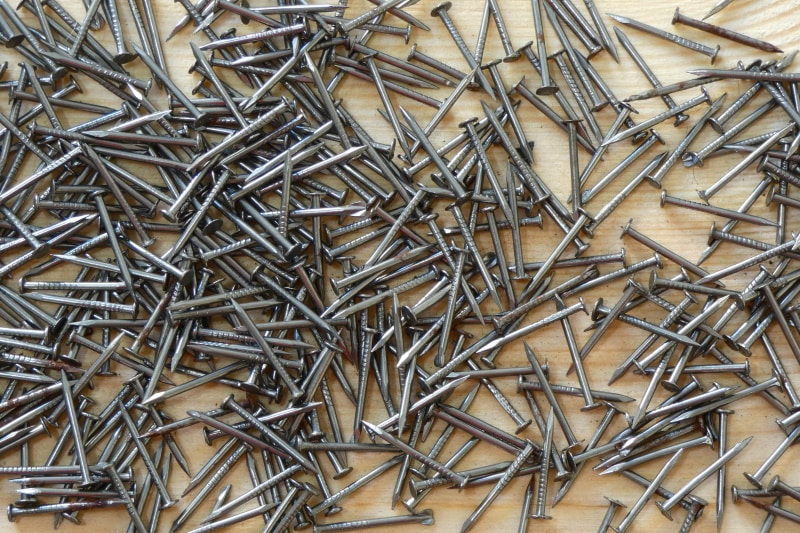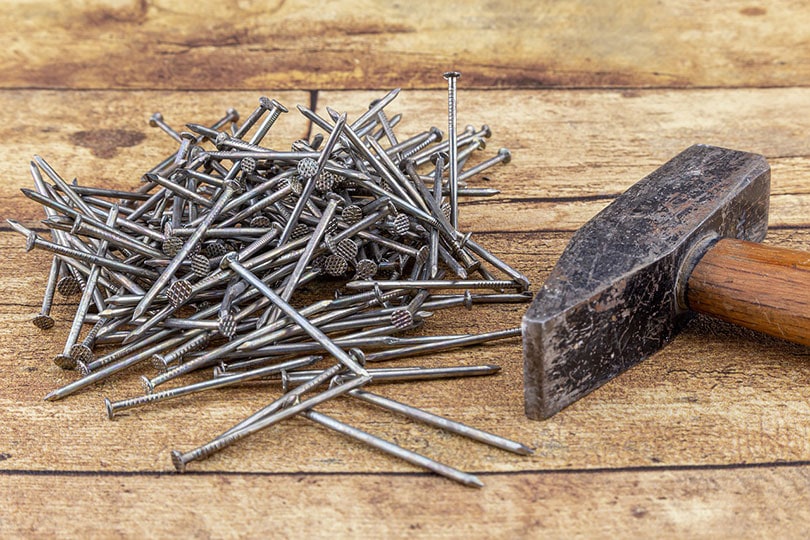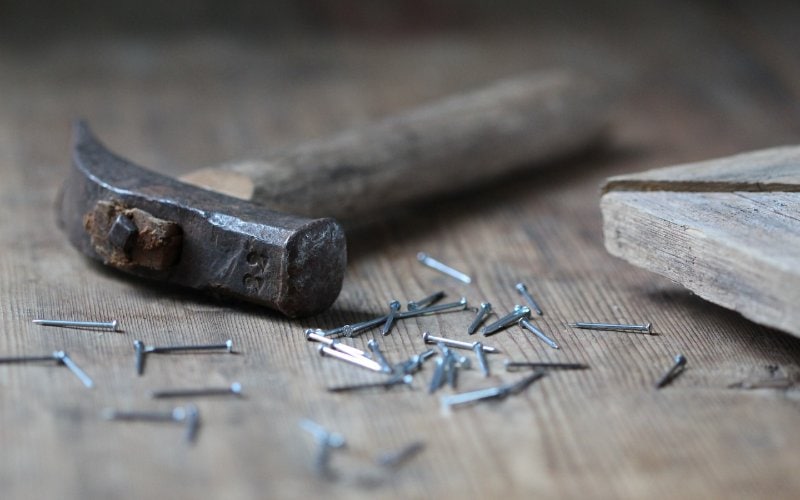What Gauge Are Framing Nails? Pros, Cons & FAQ
-
Pete Ortiz
- Last updated:

Framing requires planning, knowledge, and the right tools and materials. Nails are especially crucial since you will need to hold everything together and to last longer, you must use the correct nail size and length.
Too long nails will split the lumber, and short ones won’t solidly hold the frame properly. On the other hand, thick nails aren’t easy to drive, while thin ones don’t provide a firm enough grip. So, what gauge should framing nails be?
If you’re wondering what the correct gauge of nails is for framing, this article provides a resource that you’ll find handy when building your house. Usually, a 16d whose length is 3-½ inches will work well but there are other similar sizes available. Whether you’re using a hammer or a nail gun, the right size of the nail makes your work upstanding, smooth running, and durable in the long run.
Understanding Framing Nail Sizes
In recent decades, screws have stolen the limelight for almost all woodworking processes, but the ubiquitous nail will always have its day when you’re building structures. A nail is still the preferred fixative for making structural connections in floors, panels, trims, and roofs. That’s because they drive quickly, hold fast, and after installation, they are barely visible if well hammered.
But it’s essential to choose the right nail for the job, taking into consideration its type, size, and length for material and any special coatings.
Framing a house can’t be completed well if you don’t use the right nails. You need the perfect size for your 2×4 and 2×6 beams depending on the type of frame you’re building if you expect sturdiness and long life.
What you need is the size 16d or 16-penny nails whose length is 3-½ inches and are made from thicker 8-gauge wire, especially if you’re framing using 2x4s. That’s because they’re highly precise and ensure solid structures that meet building codes.
You can also frame with sizes 6d, 8d, and 10d gauges; your selection depends on the different-sized wood in framing joints and connector beams. The D in the nail’s name stands for diameter, also known as the penny, and it helps differentiate different nail lengths and gauges.
For outdoor purposes, most nails are galvanized or coated to forestall corrosion and rust, especially when building exterior wall or roof frames. Electroplated nails are smooth and offer moderate weather resistance, while the hot-dipped varieties are dull gray and rough, offering excellent protection.
If you’re using hardwood or pressure-treated timber, there are specialty framing nails made from copper, bronze, or stainless steel. These also apply when you’re building in high-humidity coastal areas or when your lumber is redwood or cedar as they won’t cause discoloration.

What Are the Different Types of Framing Nails?
Framing nails come in two distinct varieties, the sinker, and common nails, the difference being their head sizes. Sinkers have a textured head of 0.148-inch diameter, while common nails are smooth-headed but with a wider 0.162-inch diameter.
With sinkers, the textured head is essential to stop the hammer from slipping when building the frame of your house with 2x4s. They’re epoxy or vinyl coated, allowing for easier driving than the common nails, and are corrosion-resistant.
But if you’re using a nail gun or nailer to drive nails into your frame, the common type also works well.
These two types can be categorized further as follows:
- 6d Framing Nails: You’ll use 6d nails to attach flat wood when building your frame structure, as they’re smaller than the others used for framing. Its shank length is 2 inches, and its diameter is 0.12 inches, which is perfect for interior construction.
- 8d Framing Nails: 8d is the next gauge in the line that’s used for framing. It’s a medium-sized nail for attaching connectors and subfloors to your frame. The nails come in handy when sheathing and adding furring strips, and they’re also ideal for toenailing. Get your hands on 8d sinkers with a vinyl coating, which is common in the DIY building material market for a better framing experience. They’re like the 16d for which common nails tend to be narrow-shaped but a bit thicker in diameter.
- 10d Framing Nails: For door trimmers and added boards in your frame construction, 10d nails work best as they won’t penetrate from one end to the other. If you’re adding flat board faces, avoid this gauge as the incorrect installation will result in damage to your framing. Ensure that the nail leaves at least ¾ of an inch to have space to hammer on other attachments.
- 16d Framing Nails: The best nail for framing, especially when connecting beams and joists, is the 16d gauge, which has a length of 3.5 inches. It’s the popular choice for expert carpenters and joiners, whether you’ve selected the sinker or the common variety. Both sinkers and common 16d nails are almost similar in physical dimensions and appearance, except for the waffle-like head pattern on a sinker nail. The common variety isn’t epoxy or vinyl coated and features a smooth head, which is likely to bend with incorrect hammering.

Where Are Framing Nails Used?
For most of your framing work, you’ll either use the 8d or 16d gauge of nails when building with 2×4 lumbers. The perfect length of the main beam nails is 3 ½ inches which are the 16d’s or 16-penny’s gauge, and you can use common nails or sinkers.
You can use other nail gauges for framing depending on which part of the frame you’re working on, and these include the 3-inch 10d and the 3 ¼ inch 12d. For these lengths, use their sinker and common varieties depending on whether you’re nailing with a hammer or framing nailer.
The smaller nails are useful when you’re nailing top plates, cripples, and headers in the construction of door and window framing. Consider your frame load-bearing capacity, and if it’s not heavy such as when you’re building sheds, use other gauges besides the 16d.
Other framing applications that require specific nail gauges and sizes include:
- Framing Interior Walls: When framing your project’s inside parts, consider the load your structure will be subjected to when choosing the nail gauge to use. The common or sinker 16d made from 8 or 9-gauge wire has sufficient strength to support two-by-four beams, crosses, or studs.
- Framing Exterior Walls: The outer parts of your project require a more intricate and specific nail selection than its interior, as similarities stop at the 16 gauge. However, you’ll want to use sinker nails over common ones as exterior walls are subjected to moisture and humidity that might lead to corrosion or rust. Galvanized 16d nails are the winning choice for the external part of your frame as they’ll last longer than non-coated ones.
- Framing with 2×3 Beams or Studs; If you’re using 2×3 instead of 2×4 beams in your framing project, use 8- or 9-gauge 16d nails when your frame’s load-bearing capacity is high. You can also opt for 10d or 12d nails for top plates, door or window headers, and cripples if you’re framing small structures like sheds.
- Deck Framing Nails; It’s a different process when framing decks as opposed to interior or exterior frames. For decks, it’s recommended that you use deck screws instead of nails. That’s because these fixtures have special coatings that render them resistant to corrosion as time goes by.

Advantages of Framing Nails
Technically, nails are made by cutting long strands of solid metal wire; the most common material is steel. The steel material could be plain or bright, stainless or coated with galvanizing materials such as resins for easier driving, corrosion resistance, and durability.
Nails have various benefits over screws or other fasteners when constructing building frames, and these include:
- Providing a more robust connection as they grip wood better and aren’t likely to loosen with time
- Easier to remove in case you’re making alterations to your frame or disassembling a specific part
- Not likely to split or strip wood as screws do when over-tightened
- Less expensive, especially if you’re working on a budget
- Nails are less likely to cause irreparable wood damage when installed incorrectly
- Aesthetically, nails appear better, sink flush, and can be hidden or painted over without leaving visible heads
Disadvantages of Framing Nails
While they have loads of advantages as the traditional choice for most woodworking projects, nails also carry a few disadvantages, especially when compared to screws, bolts, and other fasteners. Part of this is due to using the wrong type, size, or gauge of the nail when dealing with lumber materials that require specialty varieties.
- The biggest downside of using framing nails over screws is that they aren’t as easy to remove, seeing as pulling them out leaves a fair amount of cosmetic damage.
- It’s also possible for small gauge nails to pop out when pressure is applied since they don’t grip into the wood as firmly as a screw would.
- If you don’t select your nails carefully or when you’re working on a budget, non-coated or galvanized nails will rust and leave marks on your painted walls.
- Nails are also prone to bending or snapping when hammering them into wood than screws, especially if they’re of a thin gauge or made from substandard steel.
- Common nails, unlike sinkers that have an epoxy or vinyl coating, don’t drive easily, and if your lumber type is hardwood, will get stuck or cause your beams to split. Screws on the other hand feature sheer, twist, and tensile strength more than nails, and they don’t lose robustness even with advanced age.
 Frequently Asked Questions (FAQs)
Frequently Asked Questions (FAQs)
What does the gauge measurement in framing nails stand for?
The gauge is equal to the diameter, which indicates the thickness of a framing nail shaft and is similar to the width of wires. If the gauge is high, the nail is thin and when a low gauge, such as 6d is indicated, it’s a thick nail.

What types of nails are used for building frames?
The 16d, 10d, 8d, and 6nail gauges, whether common or sinkers, are the most popular framing nails in use today. The 16d nail of a 3 ½ inch length is the best nail for framing when you’re using 2×4 wooden beams and studs.
What size of nailer or nail gun do you need for framing nails?
Framing nails of all sizes from 1 ¼ inch to 3 ½ inches will fit on most nail guns and work perfectly for building frames.
Can I use 3-inch or 12d nails for framing?
Although they’re not suitable for all types of framing, you can use 12d 3-inch nails for frame construction. They’re best used for building frames when the load-bearing capacity isn’t that great, such as for sheds, dog houses, chicken coops, or pump shelters.
Why do my framing nails bend so easily?
You could be using thinner nails than the recommended 16d gauge for framing if they keep bending or breaking. Ensure that you use sinker nails that are at least 8 or 9 gauge, and employ the correct hammering technique to prevent constant sliding.
Nails also bend if your lumber is very hard or has knots, and it’s best to change the position where you hammer them.

Framing Nail Chart: Size vs Length vs Diameter
| Size | Length | Diameter |
| 16d | 3 ½ inches | Sinker nails 0.148
Common nails 0.162 inches |
| 10d | 3 ½ inches | 0.148 inches |
| 8d | 2 ½ inches | 0.134 inches |
| 6d | 2 inches | 0.12 inches |
Conclusion
Having the right gauge of framing nails is a great start to completing a project that meets building code approval. Your structure will have integrity and hold up the rest of your building for years without failures that can prove catastrophic. While you can use different gauges to build frames, none have the strength and gripping power of 16d nails.
You’ll find all types of framing nails in your local home improvement store, and it’s easy to choose what you need when you know how to tell the different nail sizes apart. Telling the difference between 16d and other gauges and knowing sinkers from commons is essential if you’re to complete your project effectively and efficiently.
Featured Image Credit: Piqsels
Contents


 Frequently Asked Questions (FAQs)
Frequently Asked Questions (FAQs)